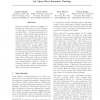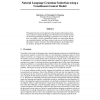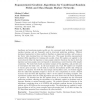11 search results - page 2 / 3 » Structural Correspondence Learning for Parse Disambiguation |
JMLR
2012
11 years 7 months ago
2012
Open-text semantic parsers are designed to interpret any statement in natural language by inferring a corresponding meaning representation (MR – a formal representation of its s...
ICASSP
2010
IEEE
13 years 5 months ago
2010
IEEE
Extractive summarization of conference and lecture speech is useful for online learning and references. We show for the first time that deep(er) rhetorical parsing of conference ...
NIPS
2001
13 years 6 months ago
2001
This paper presents a novel approach to the unsupervised learning of syntactic analyses of natural language text. Most previous work has focused on maximizing likelihood according...
ML
1998
ACM
13 years 4 months ago
1998
ACM
We introduce, analyze and demonstrate a recursive hierarchical generalization of the widely used hidden Markov models, which we name Hierarchical Hidden Markov Models (HHMM). Our m...
JMLR
2008
13 years 4 months ago
2008
Log-linear and maximum-margin models are two commonly-used methods in supervised machine learning, and are frequently used in structured prediction problems. Efficient learning of...



